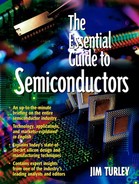Laser Surgery: Etching Away the Transistors
Once the wafer is coated with photoresist, it's light sensitive and must be kept in the dark so that it doesn't accidentally get “developed” before it's ready. Fortunately for us, the photoresist is sensitive to light we can't see, so there's no need to shut off the lights in the clean room. The wafer still needs to be handled carefully, however, to avoid scratching its delicate and carefully prepared surface.
To develop the wafer, we put it into a machine called a stepper. Usually a robot arm takes a wafer off the top of a stack and places it in the stepper automatically. Mounted just a few inches above the wafer is a copy of the film negative that the chip designers created (which was described in the previous chapter). Engineers call this film the reticle, and it's usually made of quartz instead of normal camera film. Just above the film is a lens and behind that is a bright light. Basically, we're going to project an image of the film down onto our wafer, like projecting slides onto a wall (see Figure 4.5). The only real difference is the scale: The image we project will be tiny, only a fraction of an inch on a side, just big enough to make one copy of our chip.
Figure 4.5. After a few layers have been deposited on the silicon wafer, they're removed using a chemical etching process. Special lights shine through a photographic negative, or mask, onto the chip. The light makes some of the chemicals soft so they can be washed away. The remaining material stays in place and the process is repeated.

The other difference is in the light used in our “slide projector.” It's not really light at all, in the usual sense. Human eyes can't see it, for example. Chip images are projected using light that's closer to lasers or x-rays than normal light. (Sometimes they really are x-rays.) The reasons for this are a bit complicated but have to do with wavelengths. Normal light has a tendency to bend around objects, making fuzzy shadows. Look outside and notice how the sun shining through a leafy tree casts slightly fuzzy shadows on the ground. The edges of the shadows aren't sharp. In fact, very thin objects, such as a thread or a spider web, often don't cast shadows at all because sunlight tends to bend around these small objects.
That kind of fuzziness won't work at all for making chips. We need to cast shadows that are razor sharp, especially for small objects because the transistors and wires on our silicon chip are going to be microscopically tiny. Steppers therefore use light sources that are a lot closer to x-ray machines than slide projectors. That's why these basically simple machines are 10 feet high and costs millions of dollars (see Figure 4.6). They are designed and calibrated to the nth degree to project extremely sharp, fine, focused images through the film onto our wafer.
Figure 4.6. This stepper works much like a one-hour photo lab, processing film negatives into pictures. Special laser light passes through several lenses and mirrors before finally striking the polished silicon wafer near the front of the machine. Courtesy of ASML US, Inc. Used with permission.

As the light shines through the film and onto the wafer below, it shines on the photoresist, which reacts to light and starts to harden. After a few moments of this illumination, all the photoresist that was exposed to light has “set up” and made a tough crust on top of our wafer. All the parts of the wafer that were in shadow, however, are still soft, and that's exactly what we want.
